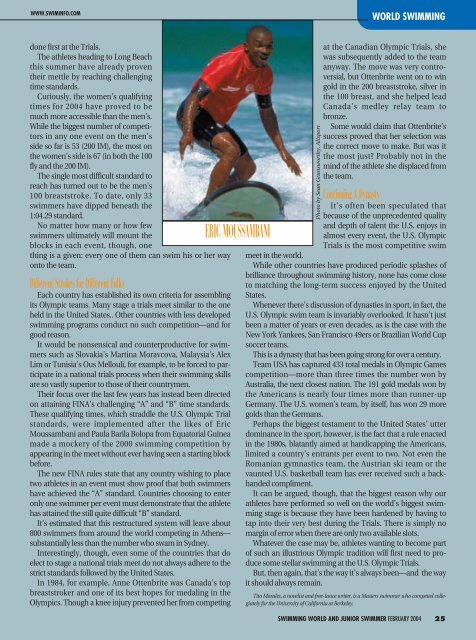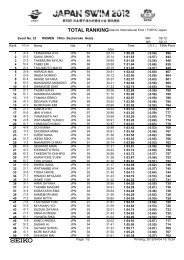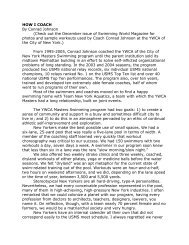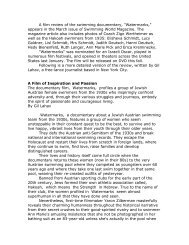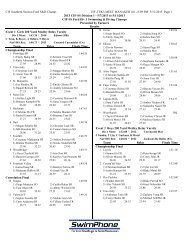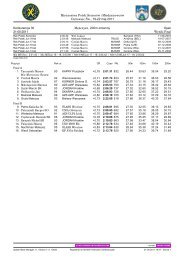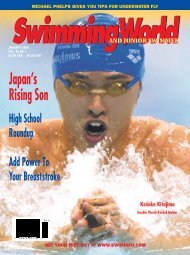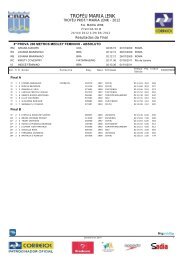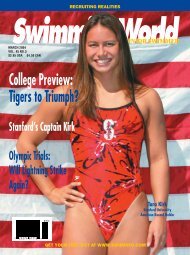Swimming World Magazine
Swimming World Magazine
Swimming World Magazine
You also want an ePaper? Increase the reach of your titles
YUMPU automatically turns print PDFs into web optimized ePapers that Google loves.
WWW.SWIMINFO.COM<br />
WORLD SWIMMING<br />
done first at the Trials.<br />
The athletes heading to Long Beach<br />
this summer have already proven<br />
their mettle by reaching challenging<br />
time standards.<br />
Curiously, the women’s qualifying<br />
times for 2004 have proved to be<br />
much more accessible than the men’s.<br />
While the biggest number of competitors<br />
in any one event on the men’s<br />
side so far is 53 (200 IM), the most on<br />
the women’s side is 67 (in both the 100<br />
fly and the 200 IM).<br />
The single most difficult standard to<br />
reach has turned out to be the men’s<br />
100 breaststroke. To date, only 33<br />
swimmers have dipped beneath the<br />
1:04.29 standard.<br />
No matter how many or how few<br />
swimmers ultimately will mount the<br />
blocks in each event, though, one<br />
thing is a given: every one of them can swim his or her way<br />
onto the team.<br />
Different Strokes for Different Folks<br />
Each country has established its own criteria for assembling<br />
its Olympic teams. Many stage a trials meet similar to the one<br />
held in the United States.. Other countries with less developed<br />
swimming programs conduct no such competition—and for<br />
good reason.<br />
It would be nonsensical and counterproductive for swimmers<br />
such as Slovakia’s Martina Moravcova, Malaysia’s Alex<br />
Lim or Tunisia’s Ous Mellouli, for example, to be forced to participate<br />
in a national trials process when their swimming skills<br />
are so vastly superior to those of their countrymen.<br />
Their focus over the last few years has instead been directed<br />
on attaining FINA’s challenging “A” and “B” time standards.<br />
These qualifying times, which straddle the U.S. Olympic Trial<br />
standards, were implemented after the likes of Eric<br />
Moussambani and Paula Barila Bolopa from Equatorial Guinea<br />
made a mockery of the 2000 swimming competition by<br />
appearing in the meet without ever having seen a starting block<br />
before.<br />
The new FINA rules state that any country wishing to place<br />
two athletes in an event must show proof that both swimmers<br />
have achieved the “A” standard. Countries choosing to enter<br />
only one swimmer per event must demonstrate that the athlete<br />
has attained the still quite difficult “B” standard.<br />
It’s estimated that this restructured system will leave about<br />
800 swimmers from around the world competing in Athens—<br />
substantially less than the number who swam in Sydney.<br />
Interestingly, though, even some of the countries that do<br />
elect to stage a national trials meet do not always adhere to the<br />
strict standards followed by the United States.<br />
In 1984, for example, Anne Ottenbrite was Canada’s top<br />
breaststroker and one of its best hopes for medaling in the<br />
Olympics. Though a knee injury prevented her from competing<br />
ERIC MOUSSAMBANI<br />
Photo by Sean Gransworthy, Allsport<br />
at the Canadian Olympic Trials, she<br />
was subsequently added to the team<br />
anyway. The move was very controversial,<br />
but Ottenbrite went on to win<br />
gold in the 200 breaststroke, silver in<br />
the 100 breast, and she helped lead<br />
Canada’s medley relay team to<br />
bronze.<br />
Some would claim that Ottenbrite’s<br />
success proved that her selection was<br />
the correct move to make. But was it<br />
the most just? Probably not in the<br />
mind of the athlete she displaced from<br />
the team.<br />
Continuing A Dynasty<br />
It’s often been speculated that<br />
because of the unprecedented quality<br />
and depth of talent the U.S. enjoys in<br />
almost every event, the U.S. Olympic<br />
Trials is the most competitive swim<br />
meet in the world.<br />
While other countries have produced periodic splashes of<br />
brilliance throughout swimming history, none has come close<br />
to matching the long-term success enjoyed by the United<br />
States.<br />
Whenever there’s discussion of dynasties in sport, in fact, the<br />
U.S. Olympic swim team is invariably overlooked. It hasn’t just<br />
been a matter of years or even decades, as is the case with the<br />
New York Yankees, San Francisco 49ers or Brazilian <strong>World</strong> Cup<br />
soccer teams.<br />
This is a dynasty that has been going strong for over a century.<br />
Team USA has captured 433 total medals in Olympic Games<br />
competition—more than three times the number won by<br />
Australia, the next closest nation. The 191 gold medals won by<br />
the Americans is nearly four times more than runner-up<br />
Germany. The U.S. women’s team, by itself, has won 29 more<br />
golds than the Germans.<br />
Perhaps the biggest testament to the United States’ utter<br />
dominance in the sport, however, is the fact that a rule enacted<br />
in the 1980s, blatantly aimed at handicapping the Americans,<br />
limited a country’s entrants per event to two. Not even the<br />
Romanian gymnastics team, the Austrian ski team or the<br />
vaunted U.S. basketball team has ever received such a backhanded<br />
compliment.<br />
It can be argued, though, that the biggest reason why our<br />
athletes have performed so well on the world’s biggest swimming<br />
stage is because they have been hardened by having to<br />
tap into their very best during the Trials. There is simply no<br />
margin of error when there are only two available slots.<br />
Whatever the case may be, athletes wanting to become part<br />
of such an illustrious Olympic tradition will first need to produce<br />
some stellar swimming at the U.S. Olympic Trials.<br />
But, then again, that’s the way it’s always been—and the way<br />
it should always remain.<br />
Tito Morales, a novelist and free-lance writer, is a Masters swimmer who competed collegiately<br />
for the University of California at Berkeley.<br />
SWIMMING WORLD AND JUNIOR SWIMMER FEBRUARY 2004 25


